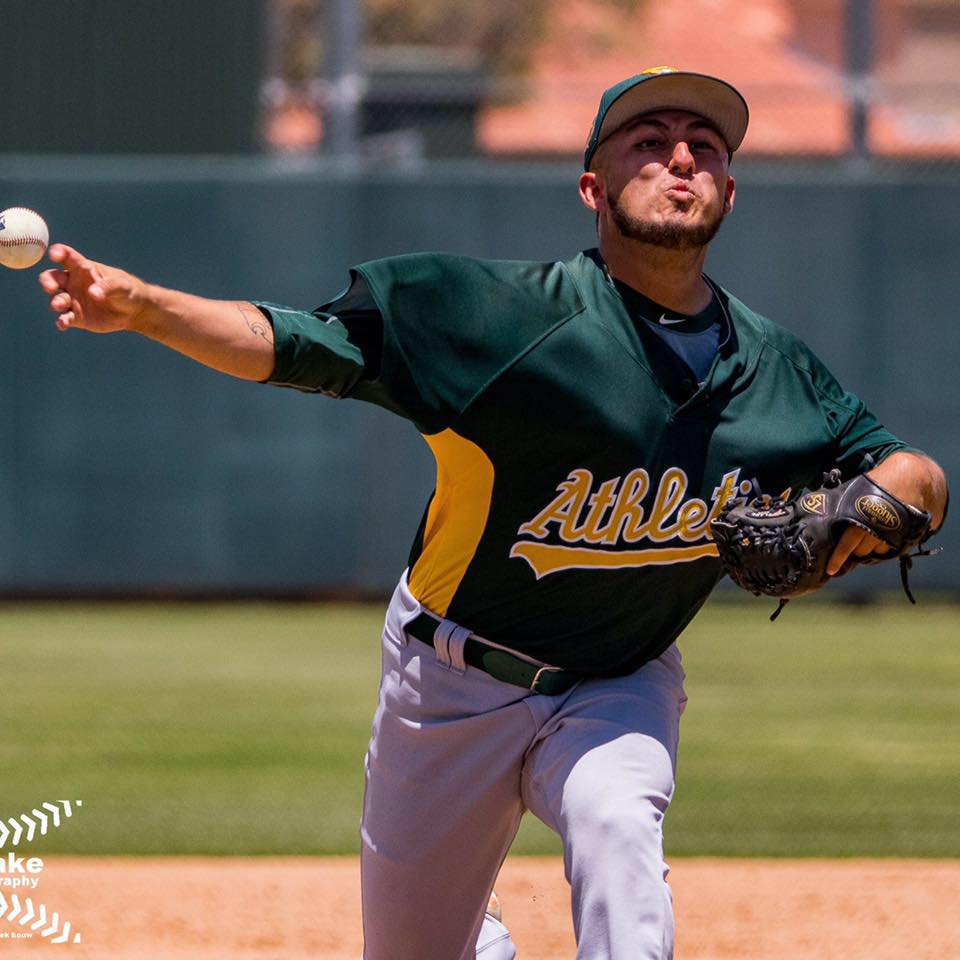Joseph Camacho: AAA RHP Athletics
1. Could you tell us your story on dropping down?
I’ve never been the tallest in the bunch, but I always threw kinda hard but had no down hill angle to the ball and was just flat. Coming out of high school I was sitting 90-92 and thought it would work at the division 1 level as it did in high school. So I ended up learning the hard way and probably gave up the most hits in NCAA. A little more than half way through the season of my freshman year the coaches decided in my bullpen to lower my arm angle to see what it would do for me, to be completely honest wasn’t really liking it at the moment but I rode it out and the last two games I had started I killed it and finished off with those two wins throwing 80-83 on the fastball. Then the next years to follow I had a record of 32-2 in the 3 years combined, had gained more velocity through the years as I got used to it all.
2. What are some of the advantages you have from your arm angle?
I believe some of the advantages are pitching with more movement and working at the bottom of the zone a lot easier. I always had a hard time pulling down on the ball and working down at the knees, moving my arm slot made it easier for me to live at the bottom of the zone and find success. Movement plays a huge role when your not pumping low to high 90’s, it sometimes helps me get away with mistakes especially when hitters see the ball in the zone like a beach ball then just sinks down.
3. If you didn't drop down, do you think you would have had the same success?
I believe that if I didn’t drop down I wouldn’t have found the same success as I did. Not many guys at 5’8 throwing low 90’s can find that much success, not saying it’s impossible but definitely tough. I firmly believe it helped cause attention for scouts to actually take a look at me rather than being just another stock righty. I do not wish I had dropped down earlier, I think I made the change at the right time. Velocity got me to college and I think that helped me out a lot but to get to the next level it’s about getting outs.
4. What would you tell someone debating on changing their arm angle?
Try it before throwing it out the window. You never know what can happen, I went from velocity being all I wanted to now movement being all I want. It’s a different sight to a hitter and they get thrown off, not many guys have the ability to throw from the side but you will never know if you don’t try. Don’t worry about the velocity when you start off, I went from the beginning 80-83 to now 88-90.
5. Are there any mechanical tips that you'd give to someone throwing sidearm/submarine?
Some tips I would advise are : make sure you stay behind the baseball until your out in front at point of release, pronation is a big key for your change up and fastball if you want sink, do not become rotational let the arm work, do not try and throw a straight fastball make it sink or cut.
6. What pitches do you throw?
Fastball (sinker) : 88-90
Cutter: 83-85
Changeup: 77-80
Slider: 77-80
7. How do you pitch to lefties/righties?
Righties: I tend to sink the ball in as much as possible with the fast and change, then when I need to will go away with the slider or cutter. Staying inside to righties is my bread and butter.
Lefties: I stay away to lefties mainly letting the ball sink away from them and will come with a outside slider or cutter. Depending on how many times they’ve seen me will go in if needed but in as close as I can so the ball wont sink back to the heart of the plate, the back foot slider is a big helper too.
8. What is your favorite part about pitching from down there?
To me the movement , watching the ball come out my hand and just watching it dance. After some games you have hitters coming up saying they don’t know which way the ball is going sometimes, and to me that’s like some one telling a person that they throw hard.





